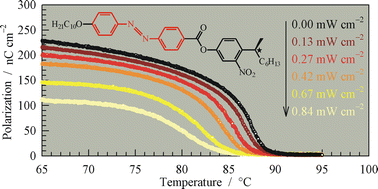The intrinsic photoferroelectric effect in the smectic C* phase of a chiral azobenzene†
Abstract
The ferroelectric properties in the liquid-crystalline smectic C* phase of the chiral mesogenic

* Corresponding authors
a
University of Stuttgart, Institute of Physical Chemistry, D-70569 Stuttgart, Germany
E-mail:
f.giesselmann@ipc.uni-stuttgart.de
Fax: +49 711 685-2563
Tel: +49 711 685-4460
b University of Strathclyde in Glasgow, Department of Mathematics, Livingstone Tower, 26 Richmond Street, Glasgow, UK
c University of Colorado at Boulder, Department of Chemistry and Biochemistry, Campus Box 215, Boulder, Colorado, USA
The ferroelectric properties in the liquid-crystalline smectic C* phase of the chiral mesogenic

 Please wait while we load your content...
Something went wrong. Try again?
Please wait while we load your content...
Something went wrong. Try again?
A. Saipa, M. A. Osipov, K. W. Lanham, C. H. Chang, D. M. Walba and F. Giesselmann, J. Mater. Chem., 2006, 16, 4170 DOI: 10.1039/B602060G
To request permission to reproduce material from this article, please go to the Copyright Clearance Center request page.
If you are an author contributing to an RSC publication, you do not need to request permission provided correct acknowledgement is given.
If you are the author of this article, you do not need to request permission to reproduce figures and diagrams provided correct acknowledgement is given. If you want to reproduce the whole article in a third-party publication (excluding your thesis/dissertation for which permission is not required) please go to the Copyright Clearance Center request page.
Read more about how to correctly acknowledge RSC content.
 Fetching data from CrossRef.
Fetching data from CrossRef.
This may take some time to load.
Loading related content
